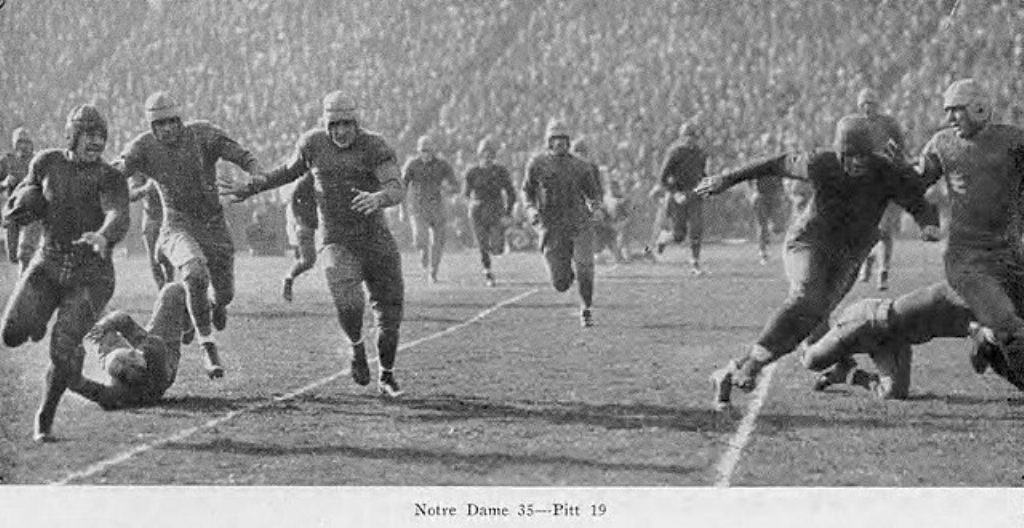The title of this series in our Football History Rewind library appropriately ends with the 1930 season. 1930 was the end of an era in football history. Not only was it the final season in the decade of the 1920s, but it was also the final year of a football legend. Knute Rockne, unbeknownst to anyone but the Creator, would coach his final season in 1930, a season considered by many to be his “masterpiece.”
Football History Rewind Part 66
Knute and His Irish Lads

October 25, 1930 Pitt versus Notre Dame game action. Image is courtesy of Wikimedi Commons.
A testament to the glory of Notre Dame football in the 1930 season starts in Illinois of all places before the start of the 1927 season. Northwestern Head Coach Dick Hanley held a coaching clinic then, and more than 100 high school coaches attended. They were so impressed with his teachings that the following year they sent him 36 “All-State” superstars to play for the Wildcats in 1930.
This team of studs breezed through the opponents on the 1930 schedule and did not have a game where they did not score at least three touchdowns during this run of success. The final game, however, was against the defending. Champs, yes, you guessed it, Notre Dame.
The Irish were also undefeated coming into the contest against Northwestern. Knute Rockne was well aware of the high-powered offensive attack of the Wildcats, and he decided to employ a strategy of field position that was performed probably better than he ever expected it to.
Rockne had Leroy Mills, one of the most gifted kickers of all time, tutor the Irish kicker, All-American Frank Carideo, in the art of coffin-corner punts. The time was well spent as Carideo placed punts out of bounds inside the 2-yard line four times during the Northwestern game!
Leroy Mills had a punting theory that he taught Carideo and others. The former Princeton kicker disliked the long spiral kicks most commonly used in football. Mills taught his students to punt the ball from the insteps of the foot, sending the ball about only 35 yards in the air in an end-over-end fashion. The kicks may only travel a mere 35 yards in the air, but they also tended to bounce in a straight line even further due to the ball rotation, adding distance to the kicks as long as they were not fielded. His other philosophical theory on kicks was to simply; “Kick ‘em where they ain’t,” thus employing a directional tactic to his pupils.
Interestingly enough, Mills was also a master of the drop kick. During the cold winter months Mills would practice inside gymnasiums. One drill, in particular, would draw crowds as he would drop kick footballs through the basketball hoops from the center court! For the encore of these sessions, he would turn around and drop kick football one after the other through the hoop at the opposite end of the court!
Northwestern could still move the ball on the Irish despite the poor field position. They amassed an astounding 350 to 40-yard offensive advantage in the first 55 minutes of the game over Notre Dame but could not score! The Wildcats twice fumbled the ball away inside the ND five yard-line and lost the game 14-0.
The Ill Fate of Coach Rockne
Rockne’s squad defeated Army 7-6 and then blew out U.S.C. in the season finale, 27-0. This would be Knute Rockne’s final football game he would ever coach. Notre Dame repeated as national champion. The Dickinson System, chose the Irish as the top team and the Number 1 position for the Irish was also the other three contemporary major selectors choice; the Boand, Dunkel, and Houlgate Systems.
The legendary football innovator would die in a plane crash in March of 1931 near Bazaar, Kansas. He is still remembered for many things; his 105-12-5 record (.881 win percentage) at the helm of Notre Dame, his speeches, his innovations of the wide-open offense, and a platoon system of mass substitutions. He also is responsible for spreading offensive tackles out further to get a better angle on defensive ends. He was a person who cared about the game of football, winning, and, most of all, his players. He lived by a creed that was inspired by his favorite poetic prayer:
Lord, in the battle that goes through life
I ask but a field that is fair,
A chance to be equal with all in the strife
The courage to strive and to dare.
And if I should win, let this be my code
My courage and honor held high,
But if I should lose, let me stand by the road
And cheer as the winners go by.
Wait a Second - A 1930 Rule Revision
The post-season Rose Bowl matchup featured two unbeaten (9–0) teams, Washington State and Alabama, ranked No. 2 and No. 3, respectively. Alabama won the Pasadena contest, 24–0.
The NCAA adopted a rule before the 1930 season, which still stands in football today. In this revision, all offense players had to stop for “one second” before the snap.
The rule helped level the playing field between offenses and defenses by disallowing teams in possession to “quick snap” the football, thus giving them a distinct advantage over their counterparts.
Conclusion
The season was beautiful and tragic at the same time in retrospect. Rockne was a maestro in full control of the music of football. He was at his peak as a coach leading the Irish to consecutive National Titles as the decade of the Roaring Twenties ended. The Great Depression, the passing of Coach Rockne and change in the football wind made this season the end of the Golden Age of football and ushered in a New Era for the game.
Special Thanks to the book of Football:A College History by Perrin, Newspapers.com, and RetroSeasons.com for the information and inspiration.





